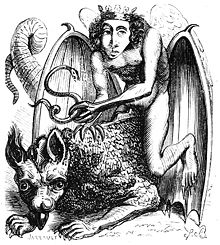Astaroth
Astaroth in demonology, is the Grand Duke of Hell in the first hierarchy with Beelzebub and Lucifer; he is part of the evil trinity. He is a male figure who is probably named after the Near Eastern goddess Astarte.
Astaroth is a crown prince of hell, an angel who became corrupted when he visited the world of man, and his fall caused much controversy as he was once a seraph and Prince of the Order of Thrones. Though he descended into evil by his own hand, this demon claims to be free of sin.
Background
The name Astaroth was ultimately derived from that of the 2nd millennium BC Phoenician goddess Astarte, an equivalent of the Babylonian Ishtar and earlier Sumerian Inanna. She is mentioned in the Hebrew Bible in the forms Ashtoreth (singular) and Ashtaroth (plural, referring to multiple statues of her). This latter form was directly transliterated in the early Greek and Latin versions of the Bible, where it was less evident that it had been a feminine plural in Hebrew.
Description
According to the Pseudomonarchia Daemonum (1577), he appears in the form of an infected angel, seated on an infernal dragon and carrying a viper in his left hand. It is indicated that the summoner must approach with a magic ring to withstand his pestilential breath. In the illustrated edition of the Infernal Dictionary (1818), he appears as a naked man with feathered wings, crowned, holding a serpent in one hand and riding a creature with dragon wings and a serpent's tail.
According to 16th century demonologists, her attacks on men are most powerful in August. His adversary is Saint Bartholomew, who protects him since he resisted his temptations. To others, he teaches math and crafts, can make men invisible, lead them to hidden treasures, and answer any question put to him. He was also said to be able to grant mortals powers over snakes. According to Francis Barret (d. c. 1801), he is the prince of accusers and inquisitors.
Appearances in Literature
The name "Astaroth" as a male demon he is found for the first time in The Book of Abramelin, supposedly written in Hebrew around 1458, and repeated in most occult grimoires of the following centuries. Astaroth is also presented as an archdemon associated with the qliphot (adverse forces) according to kabbalistic texts.
Contenido relacionado
Metis (mythology)
Jupiter (mythology)
Religion in Brazil
